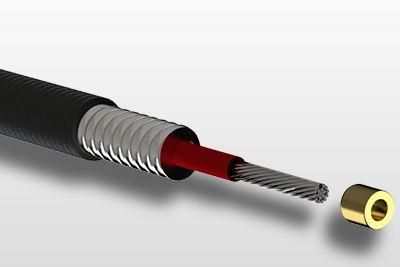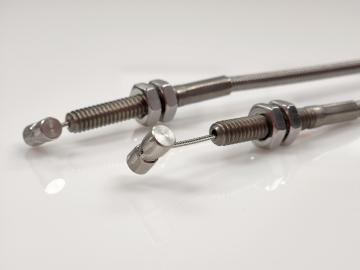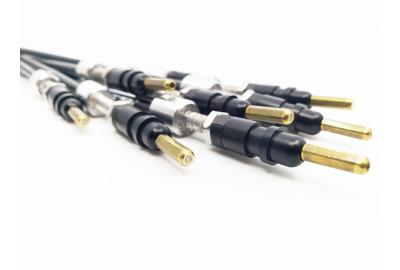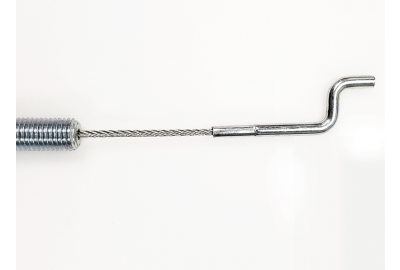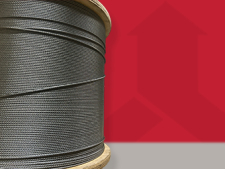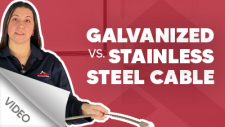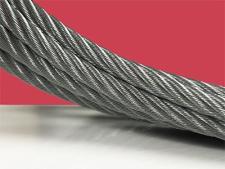Wire rope casing, or push/pull cable conduit, to which it may also be referred, is a protective tube-shaped wire rope component containing a through hole that allows an inserted solid wire or mechanical cable to smoothly transmit motion across a distance.
Commonly used in adjustment applications, such as throttles, aircraft motion actuation systems, and a wide assortment of braking applications, for example, wire rope casing is typically designed with several layered components to ensure durability and stability. Though there are wire rope casings comprised solely of nylon, however, they are less frequently used and will therefore not be addressed in this article in much detail.
The most common wire rope casing conversely includes an outermost layer commonly comprised of a High-Density Polyethylene (HDPE) coating (or jacket), which protects the steel protective housing and the cable inside from harsh environmental elements like moisture, dust, and other harmful particulates. Sometimes polyvinyl chloride (PVC) is used as well.
The second component, which resides beneath the protective HDPE coating, is an interior lining made of steel. This liner is comprised of a single, solid steel wire, spiral-like in geometry, providing the wire rope itself with both the flexibility to make a radius and the rigidity to prevent backlash or buckling while the cable is being pushed and/or pulled through the wire rope casing.
The third and final component of such a wire rope casing is an innermost sleeve, also made of either PVC or HDPE, that in either case eliminates friction between the exterior wall of the wire rope and the interior wall of the casing.
Sometimes wire rope casing is made up entirely of a single tubular length of nylon, which is commonly used in lighter-duty, lower-demand push/pull applications.


Push/Pull Cable vs. Bowden Cable
Wire rope casing is also often referred to as Bowden cable too, a motion control mechanism invented by Ernest Monnington Bowden in 1860. Bowden cable was originally invented to replace the solid rods formerly used in bicycle braking systems with a flexible, reliable mode of transmitting stopping forces from a hand braking assembly to a brake pad mechanism at the wheels.
A bit of a misnomer, however, the word cable in the Bowden cable suggests a product inclusive of a length of wire rope as well, and that’s true. In quantitative terms, a Bowden cable is defined by the mechanism that allows for smooth and reliable transmission of push/pull forces over a distance. Therefore, the operative component in a Bowden cable is not the wire rope itself, but rather the casing paired with the wire rope.
And so, although Bowden cable means a complete motion control cable assembly (or push/pull assembly) the term wire rope casing, used precisely in this way, refers only to the casing component.
The difference between the two terms therefore is that Bowden cable connotes the total, inclusive assembly, while wire rope casing, push/pull casing, and cable conduit, all connote the casing itself and nothing more.
Common Push/Pull Casing Applications
As mentioned, wire rope casing, or Bowden cable if preferred, was invented in the mid-1800s to improve how reliably, safely, and efficiently one could stop a moving bicycle. In this specific application, pull forces applied on one end created push forces on the other; hence today’s accepted push/pull cable nomenclature.
Roughly 30 years after Bowden cable’s arrival, Sir Frank Bowden, founder of the Raleigh Bicycle Company, popularized Bowden cable when he began using it in the braking systems of his bikes. Although introducing a flexible conduit to these braking systems transmitted forces comparably to that of solid rods, the inherent elasticity of wire rope casing, and the cable inside, meant bike makers could achieve braking even when forces are negotiating a bend in the bicycle’s frame.
So, where solid rods forced bike makers to transmit motion in a straight line, wire rope casing, with an equally flexible mechanical cable inside, allowed for variable geometric paths to transfer stopping forces.
In the years that immediately followed the proliferation of wire rope casing in bicycles, it was soon applied to many motion systems amid new and old innovations. For instance, in 1918, at the height of World War I, a push/pull cable assembly was used to support a machine gun triggering mechanism on a British-made Avro 504, a biplane fighter/bomber aircraft used during and more than a decade after The Great War.


Avro 504 • First World War biplane aircraft
Within a span of roughly two or three decades from then, motorcycle pioneers, like Indian used wire rope casing in the manufacturer of the throttle assemblies, and these push/pull solutions began supporting the throttle assemblies on the world’s earliest motor vehicles as well.
Today, we use wire rope casing in the push/pull cable assemblies powering our bicycle brakes and derailleurs, the throttle systems on our lawn equipment, the elevators of a commercial jet, and yes, they’re even used by NASA scientists to remotely deploy the solar sails on multi-billion-dollar asteroid-seeking satellites that are hurdling through deep space. Naturally, then it makes sense that now, wire rope casing is found ubiquitously in all manner of conveyances, including our cars, trucks, boats, aircraft, mass transit vehicles, and more.
What Types of Wire Rope Casing Are There?
At Carl Stahl Sava Industries, a US wire rope manufacturer, push/pull casing comprises:
- An outermost HDPE or PVC coating, followed by a (spiral-wound) galvanized steel jacket and an innermost HDPE or PVC liner.
- An outermost galvanized steel jacket and an innermost HDPE or PVC liner.
- A galvanized steel conduit.
- A nylon conduit.




Wire Rope Casing with an Outer HDPE Coating
The benefits of a wire rope casing that includes the added outer layer of protection HDPE provides are likely somewhat obvious.
For instance, an HDPE coating protects both the steel inner jacket as well as the wire rope from the damaging effects of UV rays or other punishing weather conditions. HDPE is quite weather resistant too, and subsequently will not expand nor contract when exposed to reasonable changes in temperature or humidity. This feature allows for a push/pull cable assembly to survive a long shelf life within conditions that might otherwise damage a more exposed motion control system.
Furthermore, the characteristic silkiness of the HDPE coating allows installers to concern themselves less with mating or nearby components as well. Oftentimes, for example, motion systems may possess some degree of functional, and thus acceptable quotient of vibration/movement. When this calculated movement is occurring, HDPE allows components sharing space to smoothly make contact with one another, whereas sans the HDPE coating, even the slightest humming may cause damage to moving and even static parts due to the unmitigated friction between neighboring components.
Wire Rope Casing without an HDPE Outer Coating
Also as discussed, sometimes the outer HDPE coating is not included in wire rope casing at all. In this instance, the spiraled galvanized steel wire is the external-facing component of the casing. Typically, but not always, such wire rope casing configurations include an interior HDPE liner, which permits the wire rope inside the casing to move smoothly.
Oftentimes the decision to use a wire rope casing that excludes the HDPE (or PVC) outermost coating deals with considerations like cost, weight, environment, or perhaps all three.
For instance, take a use case where the wire rope casing will always reside within a climate-controlled setting. HDPE is an effective way to protect more vulnerable internal components from threats like moisture, sure. But, if the push/pull cable assembly is meant to live its entire lifespan indoors, where humidity is managed, HDPE would merely add cost to the production and purchase of the wire rope casing. What’s more, if the casing’s flexibility and weight conditions, along with other essentials, all meet the engineer’s design requirements, adding features to the conduit becomes an exercise in adding only the superfluous. And in motion systems manufacturing, potential variabilities should always be limited to only those to which engineers are forced to accept.




Wire Rope Casing without any HDPE Coatings
Sometimes push/pull cable assembly applications are exposed to temperatures that might approach those that cause deformation, or more, a melting of HDPE or PVC. So, in environments where the temperature can reach anywhere between 248- to 356-degrees Fahrenheit (120- to 180-degrees Celsius), one should consider a wire rope casing that does not contain an outer coating of HDPE. In the case of PVC, the same rules roughly apply, as PVC melts at between 320- and 374-degrees Fahrenheit (160- to 190-degrees Celsius).
"If operating near the melting point of polyethylene," says Sava Manufacturing Engineer Kyle Bartosik, "wire rope casing without HDPE is recommended."
Cost considerations round out well the other benefit of using a wire rope casing comprised solely of a galvanized steel conduit. While there are significant comprises to protections of the wire rope in casings only involving steel, the assumption is that wire ripe casing of this variety does not have environmental demands of a potentially damaging nature and degree.
Ask an Engineer
A host of other mission-critical variables must be taken under consideration when evaluating wire rope casing solutions. Take for example lost motion, input load factor, tension, and compression load. While this article doesn’t seek to explain these concepts, they can be explored in detail by visiting Sava’s Push Pull Components page, which discusses these and a host of other casing design considerations. Get in touch with Sava’s engineering team to discuss your push/pull cable assembly needs today.

